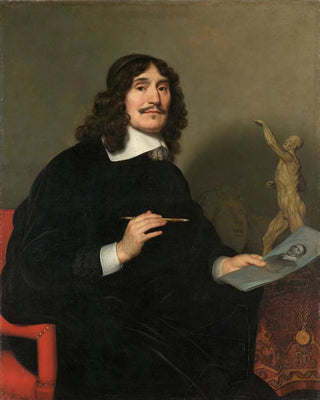Art print | Portrait of an artist - Gerard van Honthorst


View from behind

Frame (optional)
Portrait of an Artist - Gerard van Honthorst – Engaging Introduction
The "Portrait of an Artist" by Gerard van Honthorst is much more than a simple depiction. It is an immersion into the artistic universe of the 17th century, where light and shadow dance across the canvas, revealing not only the face of the artist but also his soul. This iconic work demonstrates Honthorst's technical mastery, one of the most brilliant representatives of Caravaggism, who captured the essence of his subjects with rare intensity. By contemplating this portrait, the viewer is transported to a time when art was both a quest for truth and a celebration of beauty. The art print Portrait of an Artist - Gerard van Honthorst allows you to appreciate this work from a new perspective, while preserving the richness of its heritage.
Style and uniqueness of the work
The uniqueness of the "Portrait of an Artist" lies in how Honthorst plays with contrasts, a technique he perfected over his career. Deep shadows and dazzling lights create an almost theatrical atmosphere, where every detail of the artist's face and clothing is highlighted. The color palette, rich and nuanced, evokes an emotional depth that transcends mere visual appeal. Honthorst does not merely depict his subject; he breathes life into him, giving him personality. The penetrating gaze of the artist, captured with striking precision, seems to invite the viewer to share a moment of intimacy, to question the thoughts and emotions that animate him. It is this ability to establish a dialogue between the work and its audience that gives this portrait a timeless dimension.
The artist and his influence
Gerard van Honthorst, often considered one of the masters of Dutch Caravaggism, marked his era with an innovative approach to painting. Trained in the shadow of Caravaggio in Rome, he adapted the principles of the latter to his own style, developing a chiaroscuro technique that was uniquely his own. Honthorst not only influenced his contemporaries but his work also left a lasting imprint on subsequent generations of artists. His exploration of themes of light and

Matte finish

View from behind

Frame (optional)
Portrait of an Artist - Gerard van Honthorst – Engaging Introduction
The "Portrait of an Artist" by Gerard van Honthorst is much more than a simple depiction. It is an immersion into the artistic universe of the 17th century, where light and shadow dance across the canvas, revealing not only the face of the artist but also his soul. This iconic work demonstrates Honthorst's technical mastery, one of the most brilliant representatives of Caravaggism, who captured the essence of his subjects with rare intensity. By contemplating this portrait, the viewer is transported to a time when art was both a quest for truth and a celebration of beauty. The art print Portrait of an Artist - Gerard van Honthorst allows you to appreciate this work from a new perspective, while preserving the richness of its heritage.
Style and uniqueness of the work
The uniqueness of the "Portrait of an Artist" lies in how Honthorst plays with contrasts, a technique he perfected over his career. Deep shadows and dazzling lights create an almost theatrical atmosphere, where every detail of the artist's face and clothing is highlighted. The color palette, rich and nuanced, evokes an emotional depth that transcends mere visual appeal. Honthorst does not merely depict his subject; he breathes life into him, giving him personality. The penetrating gaze of the artist, captured with striking precision, seems to invite the viewer to share a moment of intimacy, to question the thoughts and emotions that animate him. It is this ability to establish a dialogue between the work and its audience that gives this portrait a timeless dimension.
The artist and his influence
Gerard van Honthorst, often considered one of the masters of Dutch Caravaggism, marked his era with an innovative approach to painting. Trained in the shadow of Caravaggio in Rome, he adapted the principles of the latter to his own style, developing a chiaroscuro technique that was uniquely his own. Honthorst not only influenced his contemporaries but his work also left a lasting imprint on subsequent generations of artists. His exploration of themes of light and






